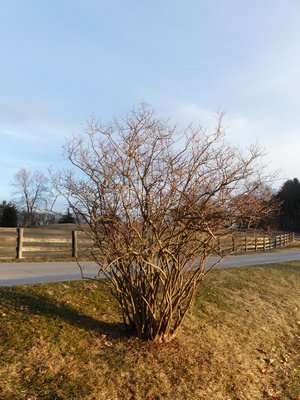

There are three fruits borne on plants that are native to Eastern Long Island. Can you name them?One is the cranberry (Vaccinium microcarpum), second is the beach plum (Prunus maratima), and the third is the blueberry (Vaccinium angustifolium).
As you may recall from previous columns or from other readings, there are great advantages to growing native plants, because they have been survivors and can easily cope with our weather, our spoils and even our pests, including deer.
But of the three mentioned above, the blueberry is probably the most versatile in terms of seasonal appeal, ease of cultivation and health benefits. And while I think all three should be used in our landscapes, it’s the blueberries that offer a fruit that can be eaten fresh off the bush, turned into jams, jellies and pies, and can be frozen for use later in the year. And now with several new varieties available, they can be grown in pots and planters, and the season can be extended for a much longer harvest.
Few locals know where the native blueberries can still be found, but, oddly enough, blueberries are now easy to find in the dead of winter at your local supermarket or green grocer. Just a decade ago, these winter crop blues were very expensive, and more often than not they had the quality of nothing more than blue mush.
How things have changed. In our current global economy, we can now get somewhat fresh blueberries from South America from November through March, at prices and quality comparable to North American crops that are available from April through August. The South American berries come from Peru, Uruguay, Argentina and Chile, who ship a combined 250 million pounds of berries to us every winter.
There is a short stretch in March when you can still find blueberries in the markets, but these are coming from cold storage, and they simply don’t have the taste that the earlier berries have. Then, in April, we begin to get a trickle of berries from Florida, then North Carolina, and eventually the classic and possibly the best commercial blueberries arrive from New Jersey.
They don’t stop there, though, because as the coastline warms up into New England, we can find some berries from Maine, Canada and even a few mixed in from Michigan. But from late June into early August, when we have clear blue skies out here, cool nights and hot days … it’s blueberry time in the Hamptons!
If you aren’t already, you should be growing your own. They can be grown in pots on patios, in patches (aptly and strangely called blueberry patches), as well as inside open-air structures called berry houses.
Known as the all-American fruit, because it truly is the most familiar of the only three fruit crops that originated here, blueberries are truly a plant for all seasons. They provide finely textured foliage that changes hue, from a delicate light green to dark emerald green, and then to crimson in the fall, with beautiful, delicate flowers in spring, followed by dark blue fruit during the summer.
At this time of the year, the high bush type is showing its winter colors, with new twig growth that can be a striking red showing against the dull browns of winter, or the white of a new snowfall.
Once established, blueberries are very easy to care for—they love our sandy, acid soil, and they will often live at your present home longer than you will. These shrubs can provide gallons of tasty fruit each year, and their nutritional merits and health-giving qualities are the stuff that legends are made of.
Add to this the fact that you will rarely, if ever, have to use any chemicals on the plants, and you’ll see that, with just a tiny bit of planning, it’s hard to go wrong with them.
To help even more, American nurserymen have been breeding blueberries for various locations and uses for more than 80 years, and you’ll be amazed at how the plants can be used in the landscape, as well as in fruit salad, jelly, muffins, pies, or all by their lonesome.
For the purposes of this article, we’ll divide the blueberries into only two groups, the highbush and the lowbush types, but you need to be aware that blueberries also can be divided into northern and southern groups. The southern groups should be avoided, because they can’t make it through our winters, but they do great in Dixie and also are widely grown in Hawaii.
The lowbush blueberries are generally not used for the commercial production of fruit, except for large native stands in New England and maritime Canada. These plants grow to only 1 to 2 feet tall, and they do best when they are burned to the ground every two or three years.
Lowbush blueberries were once quite common here, and we’d find them throughout the Shinnecock Hills and other East End areas, where they can still be found as a native shrub.
If it’s the lowbush type that you’d like to try, they do quite well out here, thank you, and several varieties make a handsome ground cover.
Angustifolium is the New England species that can range from only 8 inches all the way up to 24 inches tall, and it is somewhat drought tolerant. Bloodstone reaches only 8 inches in height and resembles English boxwood, but its evergreen foliage turns red when the weather turns cold, as do the stems.
Wells’s Delight is the creeper of the group, with runners that root when they come into contact with the soil. Hardy, but not a great berry producer, this variety is drought resistant and is an unusual, generally evergreen, plant.
The most cultivated varieties, however, are the descendants of two highbush varieties (up to 5 to 6 feet tall), one of which is called the rabbit-eye blueberry. These are the types that you are most likely to find in peak berry season, when the picking begins in North Carolina, then proceeds to New Jersey, and then up to Maine or west to Michigan, Washington and Oregon. This geographical diversity of the crops and new refrigeration techniques explain why we can get fresh berries in the stores from March through late summer.
Now, there is one teeny-tiny issue that you need to know about with growing blueberries, and I’d be remiss if I didn’t tell you: Birds go bonkers for them. I’ve seen blue jays fight over a ripe blueberry, and I’ve watched crows in nearby trees just waiting for an opportunity to swoop down for a snack as soon as I finish my morning picking. And they have an uncanny sense that draws them directly to the best berries. They also have a special word in their lexicon that tells other crows that the blueberries at your address are ripe and ready.
Fear not, though—there are a number of methods to keep the birds away, ranging from, of all things, scarecrows, to temporary netting, and for those who want the ultimate protection for the ultimate Hampton blueberry patch … there’s the berry house. This is a simple (but done in the Hampton style) wooden structure to which fencing, like chicken wire, is attached so not a single berry ends up being beaked by a crow or a jay.
Next week, the particulars: how and when to plant, varieties available, feeding and pruning.
Keep growing!
 More Posts from Andrew Messinger
More Posts from Andrew Messinger